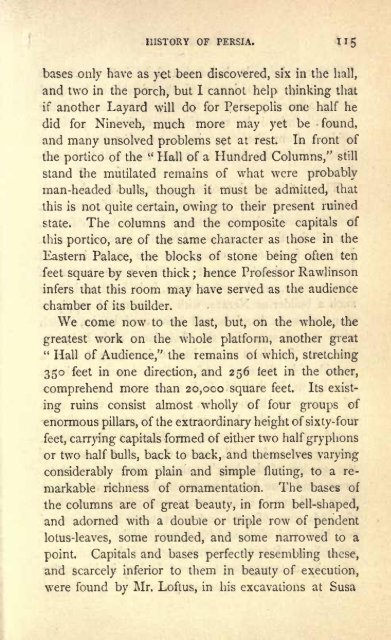Persia from the Earliest Period to the Arab
Persia from the Earliest Period to the Arab
Persia from the Earliest Period to the Arab
Create successful ePaper yourself
Turn your PDF publications into a flip-book with our unique Google optimized e-Paper software.
HISTORY OF PERSIA. 11$<br />
bases only have as yet been discovered, six in <strong>the</strong> hall,<br />
and two in <strong>the</strong> porch, but I cannot help thinking that<br />
if ano<strong>the</strong>r Layard will do for Persepolis one half he<br />
did for Nineveh, much more may yet be found,<br />
and many unsolved problems set at rest. In front of<br />
<strong>the</strong> portico of <strong>the</strong> " Hall of a Hundred Columns," still<br />
stand <strong>the</strong> mutilated remains of what were probably<br />
man-headed bulls, though it must be admitted, that<br />
this is not quite certain, owing <strong>to</strong> <strong>the</strong>ir present ruined<br />
state. The columns and <strong>the</strong> composite capitals of<br />
this portico, are of <strong>the</strong> same character as those in <strong>the</strong><br />
Eastern Palace, <strong>the</strong> blocks of s<strong>to</strong>ne being often ten<br />
feet square by seven thick ;<br />
hence Professor Rawlinson<br />
infers that this room may have served as <strong>the</strong> audience<br />
chamber of its builder.<br />
We come now <strong>to</strong> <strong>the</strong> last, but, on <strong>the</strong> whole, <strong>the</strong><br />
greatest work on <strong>the</strong> whole platform, ano<strong>the</strong>r great<br />
" Hall of Audience," <strong>the</strong> remains of which, stretching<br />
350 feet in one direction, and 256 ieet in <strong>the</strong> o<strong>the</strong>r,<br />
comprehend more than 20,000 square feet. Its existing<br />
ruins consist almost wholly of four groups of<br />
enormous pillars, of <strong>the</strong> extraordinary height of sixty-four<br />
feet, carrying capitals formed of ei<strong>the</strong>r two half gryphons<br />
or two half bulls, back <strong>to</strong> back, and <strong>the</strong>mselves varying<br />
considerably <strong>from</strong> plain and simple fluting, <strong>to</strong> a remarkable<br />
richness of ornamentation. The bases of<br />
<strong>the</strong> columns are of great beauty, in form bell-shaped,<br />
and adorned with a double or triple row of pendent<br />
lotus-leaves, some rounded, and some narrowed <strong>to</strong> a<br />
point. Capitals and bases perfectly resembling <strong>the</strong>se,<br />
and scarcely inferior <strong>to</strong> <strong>the</strong>m in beauty of execution,<br />
were found by Mr. Loftus, in his excavations at Susa

















